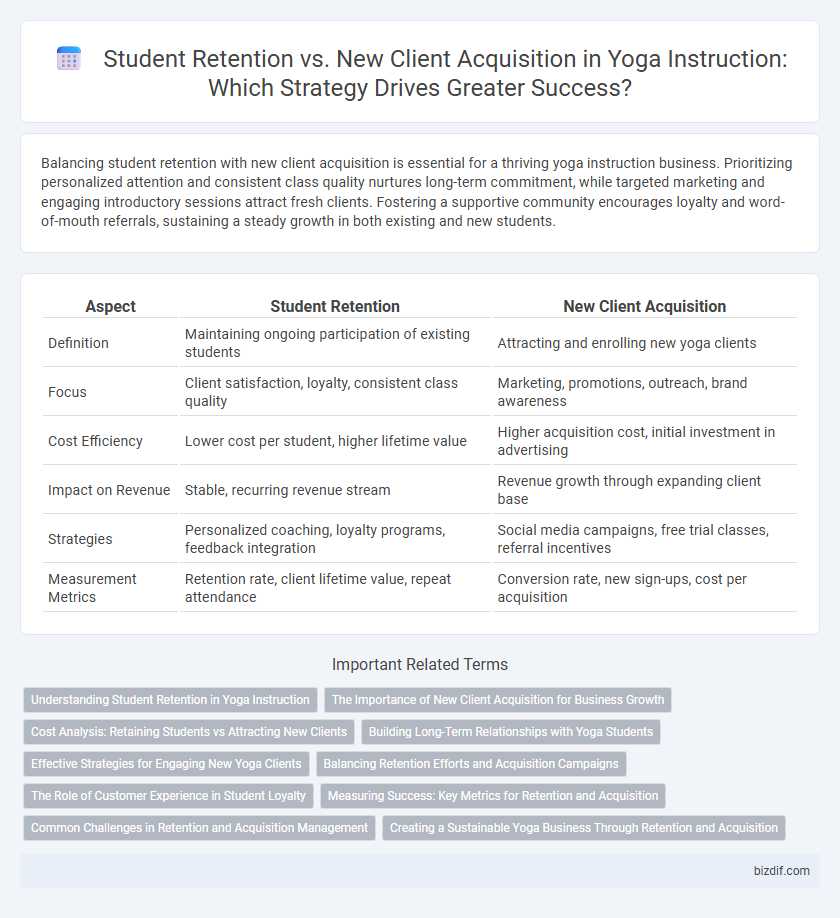Balancing student retention with new client acquisition is essential for a thriving yoga instruction business. Prioritizing personalized attention and consistent class quality nurtures long-term commitment, while targeted marketing and engaging introductory sessions attract fresh clients. Fostering a supportive community encourages loyalty and word-of-mouth referrals, sustaining a steady growth in both existing and new students.
Table of Comparison
| Aspect | Student Retention | New Client Acquisition |
|---|---|---|
| Definition | Maintaining ongoing participation of existing students | Attracting and enrolling new yoga clients |
| Focus | Client satisfaction, loyalty, consistent class quality | Marketing, promotions, outreach, brand awareness |
| Cost Efficiency | Lower cost per student, higher lifetime value | Higher acquisition cost, initial investment in advertising |
| Impact on Revenue | Stable, recurring revenue stream | Revenue growth through expanding client base |
| Strategies | Personalized coaching, loyalty programs, feedback integration | Social media campaigns, free trial classes, referral incentives |
| Measurement Metrics | Retention rate, client lifetime value, repeat attendance | Conversion rate, new sign-ups, cost per acquisition |
Understanding Student Retention in Yoga Instruction
Student retention in yoga instruction hinges on creating personalized, engaging class experiences that foster community and consistent progress tracking. High retention rates correlate with improved instructor-student rapport, tailored learning paths, and frequent feedback mechanisms. Emphasizing retention reduces marketing costs and builds a loyal client base, proving more sustainable than focusing solely on new client acquisition.
The Importance of New Client Acquisition for Business Growth
New client acquisition is essential for sustainable business growth in yoga instruction, providing a continuous inflow of revenue and expanding the studio's community. While student retention builds loyalty and stabilizes income, attracting new clients increases market reach and offsets natural attrition rates. Investing in targeted marketing strategies and introductory offers enhances visibility and encourages trial, driving long-term profitability.
Cost Analysis: Retaining Students vs Attracting New Clients
Retaining yoga students typically incurs lower costs compared to acquiring new clients, as existing students require less marketing expenditure and are more likely to commit to extended class packages or memberships. New client acquisition involves higher investments in advertising, promotions, and introductory offers to build initial trust and awareness. Prioritizing student retention enhances long-term profitability by maximizing lifetime value and reducing churn in competitive yoga markets.
Building Long-Term Relationships with Yoga Students
Fostering long-term relationships with yoga students significantly enhances retention rates by promoting consistent practice and personalized instruction tailored to individual needs. Prioritizing student engagement through community-building activities and ongoing support increases loyalty, resulting in steady class attendance and positive word-of-mouth referrals. Retention-focused strategies reduce marketing costs compared to new client acquisition, yielding higher lifetime value per student and sustainable studio growth.
Effective Strategies for Engaging New Yoga Clients
Offering personalized yoga sessions tailored to individual goals significantly boosts new client acquisition by addressing specific needs and preferences. Implementing targeted social media campaigns and referral programs enhances visibility and attracts a diverse range of potential students. Consistent follow-up and introductory workshops create a welcoming environment, increasing engagement and fostering long-term commitment among new yoga clients.
Balancing Retention Efforts and Acquisition Campaigns
Maintaining a healthy balance between student retention and new client acquisition is essential for the sustainable growth of a yoga studio. Investing in personalized follow-ups, loyalty programs, and engaging class variations can enhance student retention rates, while targeted digital marketing campaigns and introductory offers effectively attract new clients. Strategic allocation of resources ensures long-term community building without compromising fresh enrollment numbers.
The Role of Customer Experience in Student Loyalty
Exceptional customer experience in yoga instruction significantly boosts student retention by fostering a supportive and personalized environment that encourages ongoing practice. Consistent, tailored guidance and a welcoming atmosphere enhance student satisfaction, translating into higher loyalty and long-term engagement. Prioritizing customer experience over aggressive new client acquisition creates sustainable growth through word-of-mouth referrals and stronger community ties.
Measuring Success: Key Metrics for Retention and Acquisition
Tracking student retention rates alongside new client acquisition metrics provides a comprehensive view of a yoga studio's growth and sustainability. Key performance indicators include monthly retention percentages, average class attendance, client lifetime value, and conversion rates from trial classes to memberships. Monitoring these metrics helps yoga instructors refine marketing strategies and enhance student engagement for long-term success.
Common Challenges in Retention and Acquisition Management
High student retention in yoga instruction relies on consistent class quality, personalized attention, and fostering a supportive community atmosphere, which strengthens loyalty and encourages ongoing participation. New client acquisition challenges include effective marketing strategies, competitive pricing, and clear communication of unique class benefits to differentiate from other fitness options. Balancing retention and acquisition requires data-driven management practices to monitor student feedback, optimize class schedules, and implement targeted outreach campaigns for sustained studio growth.
Creating a Sustainable Yoga Business Through Retention and Acquisition
Balancing student retention with new client acquisition is critical for maintaining a sustainable yoga business. Emphasizing personalized class experiences and community-building fosters loyalty among existing students, while targeted marketing strategies and introductory offers attract new clients. Consistent engagement and quality instruction increase lifetime customer value, ensuring steady growth and financial stability.
Student retention vs New client acquisition Infographic

 bizdif.com
bizdif.com